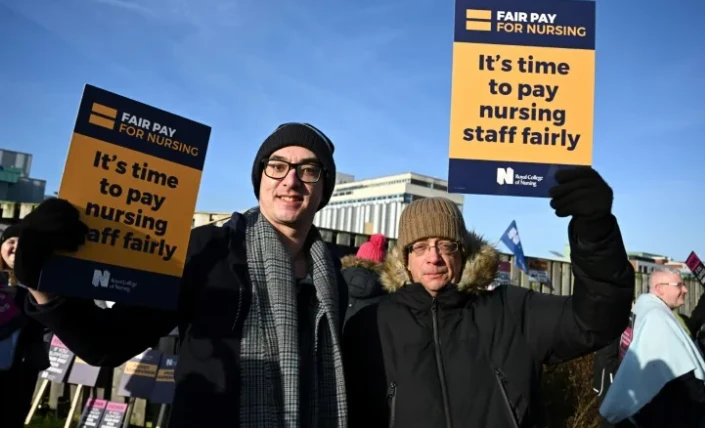From nurses to ambulance drivers, the English public health staff is on the biggest strike in its history on Monday, in a new chapter of the protests that are shaking the United Kingdom in the face of the soaring cost of living.
“We are on call 24/7, we break our backs doing the work of three people,” says Victoria Busk, a young nurse on a trauma ward at the Queen Elizabeth Hospital in Birmingham, central England, among protesters complaining of overwork due to understaffing.
“I love my job, making a difference to patients. But I can’t imagine doing this until I’m 60,” she adds.
According to a recent YouGov survey, a third of nurses and midwives in the English public sector would prefer another profession.
The Royal College of Nursing (RCN) union claims that several below-inflation increases since 2010 have caused nurses’ wages to fall 20% in real terms, to the point where some are skipping meals to feed their children and one in four hospitals in England opened food banks for their staff.
This “poor pay” contributes to 47,000 vacant nursing posts, he complains.
– All sectors
In a United Kingdom where inflation has been above 10% for months, social unrest is growing in all sectors.
Teachers – from elementary school to university – railroad workers and civil servants in many ministries staged the country’s biggest strike in more than 11 years on February 1.
Although each sector has its own specific demands, all are united in the demand for salary increases.
As a “last resort” and regretting the disruption for the tens of thousands of patients whose operations and medical appointments were cancelled, the RCN called in December the first two-day national strike in its 106-year history.
With banners reading “it’s time to pay nurses fairly,” protests were organized at the gates of major public hospitals.
But negotiation with Rishi Sunak’s conservative government was fruitless: its only result was two more strike days in January and two more, this Monday and Tuesday, in February in England and Wales.
Monday’s strike coincides with an action in England by ambulance staff – including drivers, paramedics and telephonists – resulting in the biggest strike in public health in England since the creation in 1948 of the British National Health Service (NHS).
At a time of booming seasonal illnesses such as influenza, this adds pressure to hospitals still overwhelmed by delays in treatment accumulated during the pandemic and plagued for years by underfunding.
– Limiting the right to strike
According to the health authorities, the nurses’ strike in December led to the cancellation of 30,000 operations and appointments, and the strike in January led to the postponement of 4,500 operations and 25,000 more appointments.
Despite the chaos caused in the country by the incessant strikes, 59% of Britons support the nurses’ strike, 43% support the teachers and 36% support the railway workers, according to a Public First poll published Wednesday by Politico.
But Sunak’s Conservative executive says wage demands cannot be financed from meager post-pandemic public coffers and would be counterproductive in his effort to control skyrocketing inflation.
“The governor of the Bank of England warned that if we try to fight inflation with high wage rises, the situation will only get worse and people will not be better off,” Health Minister Steve Barclay said in a statement.
Instead, the government is seeking to limit the right to strike with a bill imposing minimum services in key sectors such as health, transport and education.
But as the bill makes its way through parliament, tension is growing with unions that do not seem ready to give in.

